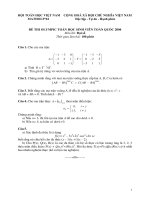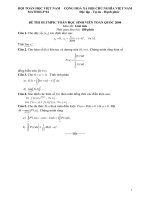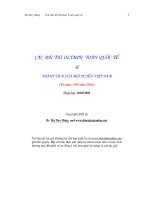Đề thi Olympic Toán học quốc tế BMO năm 2002
Bạn đang xem bản rút gọn của tài liệu. Xem và tải ngay bản đầy đủ của tài liệu tại đây (74.33 KB, 1 trang )
<span class='text_page_counter'>(1)</span><div class='page_container' data-page=1>
British Mathematical Olympiad
Round 2 : Tuesday, 26 February 2002
Time allowed Three and a half hours.
Each question is worth 10 marks.
Instructions • Full written solutions - not just answers - are
required, with complete proofs of any assertions
you may make. Marks awarded will depend on the
clarity of your mathematical presentation. Work
in rough first, and then draft your final version
carefully before writing up your best attempt.
Rough work should be handed in, but should be
clearly marked.
• One or two complete solutions will gain far more
credit than partial attempts at all four problems.
• The use of rulers and compasses is allowed, but
calculators and protractors are forbidden.
• Staple all the pages neatly together in the top left
hand corner, with questions 1,2,3,4 in order, and
the cover sheet at the front.
In early March, twenty students will be invited
to attend the training session to be held at
Trinity College, Cambridge (4 – 7 April). On the
final morning of the training session, students sit a
paper with just 3 Olympiad-style problems, and
8 students will be selected for further training.
Those selected will be expected to participate
in correspondence work and to attend another
meeting in Cambridge. The UK Team of 6 for this
summer’s International Mathematical Olympiad
(to be held in Glasgow, 22 –31 July) will then be
chosen.
Do not turn over untiltold to do so.
2002 British Mathematical Olympiad
Round 2
1. The altitude from one of the vertices of an acute-angled
triangle ABC meets the opposite side at D. From D
perpendicularsDEandDF are drawn to the other two sides.
Prove that the length ofEF is the same whichever vertex is
chosen.
2. A conference hall has a round table wthn chairs. There are
n delegates to the conference. The first delegate chooses his
or her seat arbitrarily. Thereafter the (k+ 1) th delegate sits
k places to the right of thekth delegate, for 1≤k≤n−1.
(In particular, the second delegate sits next to the first.) No
chair can be occupied by more than one delegate.
Find the set of valuesnfor which this is possible.
3. Prove that the sequence defined by
y0= 1, yn+1=
1
2
¡
3yn+
p
5y2
n−4
¢
, (n≥0)
consists only of integers.
4. Suppose that B1, . . . , BN are N spheres of unit radius
arranged in space so that each sphere touches exactly two
others externally. LetP be a point outside all these spheres,
and let theN points of contact beC1, . . . , CN. The length of
the tangent from P to the sphereBi (1≤i≤N) is denoted
byti. Prove the product of the quantitiestiis not more than
</div>
<!--links-->









